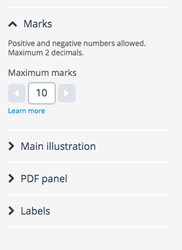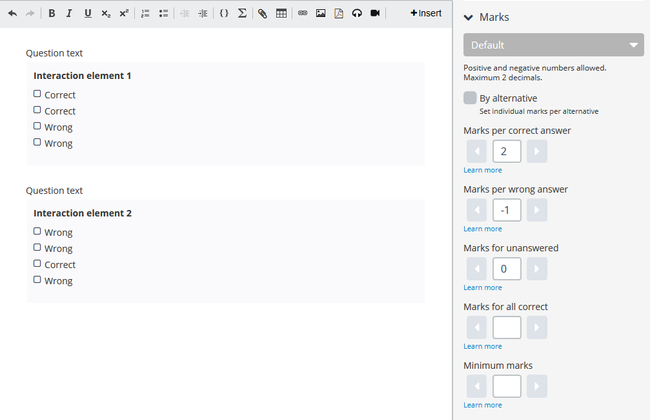Versions Compared
Key
- This line was added.
- This line was removed.
- Formatting was changed.
| Warning |
|---|
This article will no longer be updated. New article available at support.inspera.com. Norwegian: Poenggivning for oppgaver - Enkel og Poenggivning for oppgaver - Avansert English: Question Scoring - Basic and Question Scoring - Advanced |
This article describes how you can award automatic marks to a question that contains alternatives.
Overview:
| Table of Contents |
|---|
Setting maximum marks for manually marked questions
The Maximum marks defines the highest possible number of marks a grader may give to a candidate answer in the grading tool. When creating a manually marked questions, the author can define the maximum marks.

Simple scoring
| Tip |
|---|
Always answer the question in preview mode to check that marks are awarded as intended. |
Applies to all automatically marked questions.
For all question types the author can set the scoring rules in the panel to the right of the editor. The simple scoring rules supports:
- Marks per correct answer
- Marks per wrong answer
Scoring per alternative
| Tip |
|---|
Always answer the question in preview mode to check that marks are awarded as intended. |
Applies to Multiple Choice, Multiple Response, True/False, Inline Choice.
When you select the "By alternative", "Marks per correct answer" and "Marks per wrong answer" will be disabled.
To define the marks per alternative you have to focus on the interaction in the editor.
In the panel on the right you can define marks per alternative. This must be defined for all interaction elements in the question.
Image Modified
Scoring - Advanced
| Tip |
|---|
Always answer the question in preview mode to check that marks are awarded as intended. |
| Note |
|---|
It is not possible to change the scoring after the test has started. |
The advanced scoring rules supports:
- Marks per correct answer (included in simple scoring)
- Marks per wrong answer (included in simple scoring)
- Marks for unanswered
- Marks for all correct
- Minimum marks
Marks per correct answer, marks per wrong answer and marks for unanswered must have a value.
Marks for all correct and minimum marks do not reqiore a value, and if these are not to be used in the scoring rules, they must be left empty.
Advanced scoring with several question elements
In the following image you see an example of several question elements in the same question.

When several question elements are used it is important to be aware of which settings applies to the elements, and which settings apply to the complete question.
Applies to each question element:
- Marks per correct answer
- Marks per wrong answer
These settings are the general rule for marking.
Exceptions can be defined in upper and lower mark limit per question element. More on that later in the article.
Applies to the question as a whole:
- Marks for unanswered (All question elements must be unanswered)
- These are the marks awarded if all question elements are unanswered.
- If one question element is answered, the remaining unanswered ones will be marked as wrong answer
- This setting must have a value, and default is 0.
- Marks for all correct
- These are the marks awarded if the learner gets all answers correct.
- These are not bonus points - they don't stack with the max achievable marks.
If this is set to a lower value than maximum achievable marks, the result is that a learner with all correct answers may achieve a lower score than learners with one or more wrong answers. - This setting does not require a value and is empty by default. When it is left empty, the marks for all correct will be defined by maximum achievable marks as set in marks per correct answer.
- Minimum marks
- If this is not set, the lowest achievable score will be defined by the settings on the options above.
- If this is set to 0, the question will never award negative marks.
- This setting does not require a value and is empty by default.
Lower and upper mark limit per question element
Individual question elements can have their acheivable marks further limited. This can be set up in Options per question element. Using this will override the marks per correct and marks per wrong answer.
If you do not want to use this, please leave the setting empty. Any other value will be a part of the scoring rules.
Click on the question element to get the Option menu available on the right.
Upper mark limit: This can be used if you want to override marks per correct answer. If this is set to a lower value than marks per correct answer, the upper mark limit will override marks per correct answer.
Example:
A question consists of four question elements, each with one correct answer. Marks per correct answer is set to 2, and the question can award a maximum of 8 marks.
Setting the upper mark limit on one of these elements to 1,5 changes the maximum to 7,5 acheivable marks.
Caution: Setting upper mark limit to 0 means that the question element cannot award positive marks at all.
Lower mark limit: This can be used if you want to override marks per wrong answer. If this is set to a value that is higher than marks per wrong answer, the lower mark limit will override marks per wrong answer.
If the question in the general scoring rule is set to award negative marks per wrong answer and the lower mark limit is set to 0, the element will not award negative marks
Setting a lower mark limit is useful in those cases where you want to limit the impact of one wrong answer compared to the other wrong answers.
Note: If the value of minimum marks set on the question is higher that the sum of all lower mark limits, the minimum marks setting will override the combined lower mark limits.
Example of scoring using a multiple response question with two question elements that both have two correct and two wrong answers:
Marks per correct answer: 2
Marks per wrong answer: -2
Lower mark limit on question element: -3
The candidate gets all correct on question element 1 and all wrong on element 2:
4 marks are achieved for element 1, and -4 for element 2.
The result without a lower mark limit will in this case be 0 of 8 marks.
But because we have a lower mark limit of -3 on both elements, the final result will be 1 of 8 marks.
If the candidate answers all wrong, the result will be -6 of 8 because of the lower mark limit.
Remove the lower mark limit, and all wrong will result in -8 of 8.
Any minimum marks set on the question will override all of the above.
A more extreme example of setting minimum marks to 7 will award 7 of 8 marks on every possible combination of answers, except for all correct which will award 8 of 8.